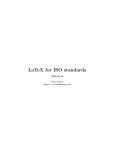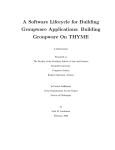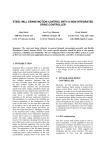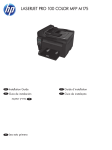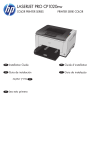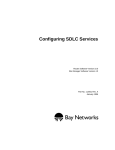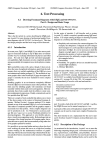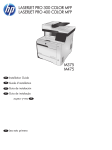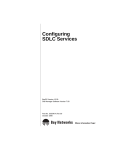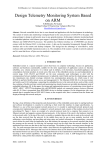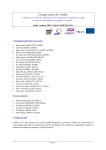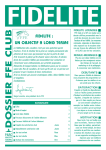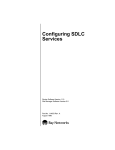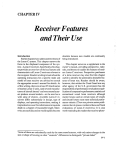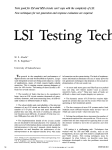Download The new crane motion control concept with integrated drive
Transcript
CONTROL NETWORK AS BACK BONE OF THE CRANE MOTION CONTROL SYSTEM Alojz Slutej ABB Automation Systems 72167 Västerås, Sweden [email protected] phone: +46 21 340 528 fax: +46 21 340 290 Fetah Kolonić Faculty of Electrical Eng. and Comp. Unska 3, HR-10000 Zagreb, Croatia fetah.kolonić@fer.hr phone: +385 1 6129 824 fax: +385 1 6129 705 Key words Control network, integrated crane control, distributed multidrive systems, application controller, digital drive controller, AC machines, TCP/IP protocol, fast multidrive field bus link. Abstract Requirements of modern cranes and another heavy-duty material handling systems result in demand for sophisticated crane control and automation systems capable of handling loads fast and reliable connection to the particular information systems. These systems continuously provide up-dated information about containers moves and crane status. The total function is built up of a number of distinct building blocks installed from the beginning or added on after. Many of the building blocks are tightly connected to each other to achieve the right functionality and performance. For steel mill cranes and another similar industrial systems special attention is paid to the systems robustness, reliability and availability. Generally, the crane motion control system supports positioning, brake control, and another application function. In order to achieve a number of different possibilities to solve engineered problems, the multidrive concept is applied. Mentioned concept includes: powerful process controller with advanced multitasking, capable of handling several real time critical control loops simultaneously, high speed communication links between different clients, accurate measurement and fast transmission of drive positions and speeds and centralized interface for diagnostics of the complete system. This paper presents the important features of Control Network used in crane motion concept with Digital Drive Controller (DDC) system. DDC system, based on operational flexibility through standardized hardware and software modules, offers a solution for many engineered crane application problems. 1. Introduction The Integrated Crane Control system is designed for handling of the complete control and automation of a container crane. The total functions are built up of a number of distinct building blocks that can be installed from the beginning or added on after the delivery of the crane. Many of the building blocks are tightly connected to each other and requires as system designed and built with the total functionality to achieve the right performance (Fig.1). Panels •Crane driver •Checkers cabin HV Switchgear Main Trafo Aux. Trafo CMS TCP/IP Main Controller Field Bus PLC PLC R-I/O MCU MCU MCU MCU MCU I SACE F2 MCU o MCU o MNS® PK MCU MCU MEGAMA X MCU PR112 PR1 Main Drive Line Up MNS® MCU MNS ® LV Distr. MCC R-I/O R-I/O LPS Sensors Limit Switches Main Motion Motors TPS Local Control Boxes Fig 1. Crane topology. The basic drive and control package has to be designed to handle the real time and communication requirements of the automation functions. Bus Administrator (BA) achieves communication to the Supervisory System with standard field bus protocol. Supervisory System for the crane application (Fig.2) connects all cranes via TCP/IP communication network and optical hubs connected to the Crane Information Management Server (CIMS_NT). Crane1 CMMS 6.0 Cabin view Checkers view HUB IEEE802.3, TCP/IP AC410 Hub Crane 2 Remote CMMS Crane IMS_NT Crane n Fig 2. Crane supervisory system. The maintenance functionality on the crane is concentrated in the Crane Monitoring and Maintenance System (CMMS). The complex distributed applications based on the control network facilities should be capable to fulfil all requirements for framework of crane modernization. The majority of open distributed applications are based on the client-server communication model. This means that client or application process accessing and using server as remote file system. A single server process supports access requests from a distributed community of clients concurrently. Part of the distributed application could be Distributed Multidrive System (DMS) as a basic concept with the number of different possibilities to solve particular engineering problems. Direct integration of variable speed drives into the overall process control system by way of Control Network Link (CNL) EPE-PEMC 2002 Dubrovnik & Cavtat P. 2 and Fast Multidrive Field bus Link (FMFL), brings about a number of advantages, such as simplified connections, consistent operator supervision or control and improved application program legibility. In DMS, several Application Controllers (APC) are interconnected by FMFL where each drive is used as separate node. Common control functions are distributed to separate nodes by the use of digital communication. The APC takes care of the specific control functions a basically, it could be a single board controller with all software and hardware facilities needed for a single or multidrive systems. The functions of the drive controller are independent whether a DC or AC drive applications are used. For communication to the common overriding control system CNL is used. Mentioned link ensures high performance, reliability, and availability required for DMS application. 2. Control network link The Control Network Link (CNL) provides real-time communication link between various clients or controllers in a complex DMS (Fig.3). Yard planing system Administration system RCMS Crane 1 Crane 2 Crane 3 Crane n Fig 3. Crane network topology. These links are local to the respective clients and can only communicate with clients connected to the same bus. CNL is designed in accordance with ISO's seven-layer model for Opens System Interconnection (OSI), [1]. It is used for the time critical, real-time communication within the distributed control system. When two or more networks are involved in an application, the mode of working is normally refereed to as internetworking [1], [2]. The term internetwork or Internet is used to refer to the composite network. Each constituent network is referred to as a subnet. It is assumed that each network is of a different type and hence that the router will have a different set of network protocols associated with each network part. Control network based on Internet is assumed as a subnet. The CNL’s Medium Access Control (MAC) standard together with associated physical media specification (contained in the IEEE 802.3 Carrier Sense Multiple Access with Collision Detection (CSMA/CD) standard's document) are implemented [3], [4]. The MAC sublayer provides the method by which devices access the shared network transmission medium. The Logical Link Control (LLC) sublayer provides a network interface to upper-layer protocols and is concerned with transmitting data between two nodes on the same network segment. The Internet Protocol is one protocol associated with the complete protocol stack and it is known as TCP/IP protocol (Transmission Control Protocol/Internet Protocol). Protocol is now widely used in many commercial and research Internets and includes transport and application layers. Networking protocols layers are responsible for a different facet of the communication. A protocol EPE-PEMC 2002 Dubrovnik & Cavtat P. 3 suite for used TCP/IP protocol is the combination of different protocols at various layers and is considered to be a minimized 4-layer system. The data link layer or network interface layer includes the device driver in the operating system and corresponding network interface module. This module handles all the hardware components of physically interfacing to the network Media. Network layer or Internet layer supports the movement of packets around the network as well as routing of packets. Internet Protocol, Internet Control Message Protocol together with Internet Group Management Protocol provide the network layer in the TCP/IP protocol suite, [5]. Transport layer supports a flow of data between two hosts. TCP/IP protocol includes two different transport protocols: TCP (Transmission Control Protocol) and UDP (User Datagram Protocol). TCP and UDP are two predominant transport layer protocols and both use IP as the network layer [6], [7]. TCP provides a reliable transport layer; UDP sends and receive datagrams for applications. The application layer is direct interface to the user application program and could include: Telnet, FTP (File Transfer Protocol), SNMP (Simple Network Management Protocol), SMTP (Simple Mail Transfer Protocol). Telnet provides services to enable a user application program to log on to the operating system of remote device. User can communicate interactively with another application process as if the user terminal was connected directly to it. FTP enables user application program to access and interact with remote file system. Access to a remote file server is a basic requirement in many distributed control applications. SMTP manages the transfer of mail from one system mail to another. SNMP is concerned with management of all the communication protocols and supports the total network environment. API (Application Programming Interface) for application using the TCP/IP protocols called sockets and TLI (Transport Layer Interface). A socket is end-point for communications that get bounds to the UDP or TCP port within the node. One application layer creates a TCP stream socket and binds it to a particular well-known port number. Next application layer in the host device creates another stream socket which one will request connection to the previous socket by specifying its host Internet address and port number. Once the two TCP sockets have been thus connected, there is a virtual circuit set up between them. Up to five different protocols or sockets could be created. The socket layer contains a certain number of paired "calls" and these routines protect code that accesses data structures shared between the socket layer and the protocol-processing layer. The board communication software support package uses a client-server communication model. The main server reads requests and, if requested, sends a reply back to the client. The client builds the request according to the specific application layer, sends message and waits for a reply to be sent back. Application Controllers (APC) are interconnected by FMFL where each drive is connected as separate node. High Level Data Link Control (HDLC) protocol is an international standard (defined by ISO for use on both point-point and multidrop data links) and is used in this application. It supports Layer 2 of the seven-layer OSI model and is called data link layer. HDLC uses a bitstuffing process to ensure that bit pattern of the delimiter flag does not occur in the fields between flags. The HDLC frame is synchronous and physical layer provides a method of clocking and synchronizing the transmitter/receiver. It uses both data and control messages carried in a standard format frame (Fig.4). EPE-PEMC 2002 Dubrovnik & Cavtat P. 4 Start Delim Frame header 8 bits Flag 8 bits 8 bits Address Control I -frame Check End Delim 0 to N bits Information 16bits C RC 8 bits Flag Direction of transmission D0 D7 Information 0 Ns P/F Nr Ns - Send sequence number Nr - Receive sequence number P/F - Poll/Final bit D0 1 Supervisory D7 0 S P/F Nr S: RR - Receiver Ready RNR - ReceiverNot Ready REJ - REJect SERJ - Selective REJect D0 Unnumbered 1 D7 1 U P/F U Unnumbered SARM - Set Asyn Resp Mode Commands: SARME - Set Asyn Resp Mode Ext SNRM - Set Normal Resp Mode SNRME - Set Normal Resp Mode Ext SABM - Set Asyn Balanced Mode SABME - Set Asyn Balan Mode Ext RSET - Reset FRMR - Frame Reject DISC - Disconnect Unnumbered UA - Unnumered Acknowledge Responses: CMDR - Command Reject FRMR - Frame Reject DM - Disconnect Mode Fig.4. Frame format. 3. Multidrive system Multidrive system for engineered drive applications includes: built-in distributed application control, open communication and advanced PC based tools for application programming, commissioning, trouble shooting and drive monitoring ( Fig 5.) AC Common DC Bus Control Control AMC AMC AMC AMC Inverter Inverter Inverter Inverter Supply Unit AMC AMC AMC AMC Inverter Inverter Inverter Inverter (rectifier) AC Single drives: MultiDrive: • Independent frequency converters • Common AC input • Less components • Regenerative or resistor braking for several inverters • Motor to motor braking with common DC bus Fig 5. Multidrive system. The Application Controller (APC), common for both DC and AC drives, is basically a single board controller with all the software and hardware facilities needed to handle the application specific functions, [8]. In distributed controller systems, several application controllers are interconnected by fast communication link where each drive can be used as a node. Common control functions are EPE-PEMC 2002 Dubrovnik & Cavtat P. 5 distributed to separate nodes by the use of digital communication. As well, APC's can communicate with external systems with communication boards. 4. Digital Drive Controller The Digital Drive Dontroller (DDC) is normally equipped with speed measurement facilities, and could be configured as either torque or speed controller. DDC software is fixed but various functions and operating modes can be selected via parameters and is controlled by either a torque or a speed reference provided by the APC. For steel mill cranes and another heavy duty material handling systems, ABB ASTAT Digital Drive Controller (DDC) is used, [9], (Fig 6). Power supply Signalization Fault tracing Cabin unit Cabin No.1. unit No.1. Signalization Fault tracing Cabin unit Cabin No.2. unit No.2. Control module Main control board Main control board PC Servis terminal, Service Tool, Developing system Thyristor module Firing unit Firing unit with current with current feedback feedback External rotor resistors Process Process unit unit Rotor Rotor frequency frequency estimation estimation unit unit Brake Rotor Rotor adoption adoption unit unit Slip-ring motor Fig.6. ASTAT block diagram. It is a speed or torque control system for slip-ring AC motors. Performs stator and rotor control functions. Because the available motor torque of induction motor is proportional for each speed to the square of the stator voltage, the speed control is obtained by varying the stator voltage so that the desired speed is obtained for a given load. Rotor control gives to the motor the right characteristics optimizing the external rotor resistance. Supports positioning, brake control, rotor step switching and another application functions. The control system also includes protective functions that are necessary for crane motor drives application. ASTAT is on line programmable and various functions and operating modes can be selected by fixed number of parameters. The power electronics is made in a modular form which supports the integration into the cranes structure. The space requirement is low, and the temperature withstandability is high. The control module is generating the firing pulses to the thyristors module. All control system connections are made by optical fiber. The motor control programs are located in the control system module. Commissioning and Maintenance Tool (CMT) is PC based program for DDCs. The CMT is monitoring reference and actual values, parameters handling and displaying data loggers. The Process I/O basic software support and different communication drivers are located in the control module. EPE-PEMC 2002 Dubrovnik & Cavtat P. 6 4. 1. Main Control Module The control system module is built up around the Motorola MC68332 microcontroller unit, (Fig.7). M easurem e Line S tator M otor T em peratu Local 2 x 7th D ispla TP U C ontro Firing pulse B ridge change QSP Pow er 24 V in, 5V Supervisio QSM M C 6833 RW fPR O D ata Address C ontrol H ost O pen O pto 4 SeriaC om m DCB RS P I/O Field Bus O pto Link 1 CMT R S 485/R S Fig.7. Control system module block diagram. The control board comprises a number of connectors interfacing other boards or devices. The MC68332 is a 32-bit integrated microcontroller with powerful peripheral subsystems [2], and includes an external interface and various functions that reduce the need for external glue logic. The CPU module configuration registers allows the user to configure and monitor the system according to the system requirements. The local operating system software sets up the system after a power on reset. The process I/O and Master/follower communication interface is a high-speed data link based on the SDLC standard protocol [1]. The PC based Service Tool can communicate with any DDC connected to the bus. The PC is connected to the RS232/RS485 interface (115.2 kBit/s) of one DDC and communication to the other DDC's on the same bus is easily accomplished. The messages are relayed back and forth through that one DDC, [3]. 4. 2. Process I/O Control Module The control module for different type of process I/O units is built up around the Motorola MC68302 microcontroller unit [10], [11]. The control module (Fig.8.) comprises a number of connectors interfacing other boards or devices: Control board, another process I/O modules and service terminal. The MC68302 is a 32-bit Integrated microcontroller with powerful peripheral subsystems. The device is especially suitable to applications in the communications industry for a wide variety of DDC’s. The main Communication Processor (CP) is a RISC processor that services the three Serial Communication Channels (SCC). Serial Direct Memory Access channels are associated with three full-duplex SCCs. Each channel is permanently assigned to service the receive or transmit operation of one of the SCCs and is always available, regardless of the SCC protocol chosen. EPE-PEMC 2002 Dubrovnik & Cavtat P. 7 P I/O Comm. Opto Link EX P I/O Comm. Opto Link SCC1 SCC2 SCC3 MC66302 RWM DAPU 100 Service Comm. DCB Prot. RS 232 fPROM Power supply 24 Vin, 5V ±15V Supervision Data Bus Address Bus Control Bus Digital Inputs Digital Outputs Analogue Inputs Analogue Outputs Pulse Enc Reference Digital Outputs Analogue Inputs Analogue Outputs Pulse Enc Reference RFM Torque DATX 110 Digital Inputs DATX 130 DSP Rotor DSP Stator Fig.8. Process I/O control module block diagram. 5. Conclusion The CNL provides real-time communication link between various clients or controllers in a DMS application. These networks are local to the respective clients and they are used in the complex DMS to integrate a variable speed drives into overall process control system application. The CNL is based on the Ethernet/IEEE 802.3 (TCP/IP) protocol and provides a connection-oriented data stream service between the two end points of user application process. The term stream is used since it treats all the user data associated with a sequence of request and response messages. Communication module supports access to the CNL and creates a direct logical interface to the CNL protocol suite via different sockets. The stream socket layer maps protocol-independent requests from application layer to the protocol-specific implementation. Up to five different protocols or sockets could be selected and serviced within less then 20 ms. The FMFL is based on the HDLC protocol and is used in multidrop configuration. It supports Layer 2 of the seven-layer OSI model and is called data link layer. Guaranteed data exchange between different clients should be less then 2 ms. Presented Digital Drive Controller for slip-ring AC motors is suitable for cranes applications where system robustness, reliability and availability are basic requirements. It supports positioning, brake control, rotor step switching and another application functions. DDC performs stator and rotor control functions. Stator control is related to the torque control. Rotor control, by optimising the external rotor resistance, gives the motor the right characteristics. As a particular sub-system, DDC can be linked in a superior overriding level for industrial automation and information interchange. 6. References [1] [2] [3] [4] [5] [6] [7] [8] Halsall, F.: Data Communications, Computer Networks and Open systems, Addison-Wesley, 1992. Rago, S.A.: UNIX System V Network Programming, Addison-Wesley, 1993. IEEE Pub.: 802.3 CSMA/CD Access Method and Physical Layer Specification, IEEE, 1985. IEEE Pub.: Logical Link Control ANSI/IEEE Std., IEEE, 1985. Postel, J.B.: Internet Control Message Protocol, RFC 792, 1994. Stevens,W.R.: TCP/IP Illustrated, Addison-Wesley, Vol.1, 1994. Stevens, W.R.: TCP/IP Illustrated, Addison-Wesley, Vol.2, 1994. Slutej, A.: The new Multidrive concept for engineered drive application, invited paper, in Proceedings of Conference on Microcomputers in control systems, Mipro’94, Rijeka, Croatia, vol.2, 1994. pp.1-5. [9] ABB Automation System.: ASTAT Manual, CD ROM, 2001. [10] Motorola.: Quad Integrated Communication Controller, 1995. [11] Motorola.: Integrated Multiprotocol Processor, User’s manual, 1991. EPE-PEMC 2002 Dubrovnik & Cavtat P. 8 Analphabetic list of important shortcuts: APC APlication Controller API Application Programming Interface BA Bus Administrator CIMS Crane Information Management Server CMMS Crane Monitor Management Systems CNL Control Network Link CSMA Carrier Sense Multiple Access DDC Distributed Drive Controller DMS Distributed Multidrive System FMFL Fast Multidrive Fieldbus Link FTP File Transfer Protocol HDLC High speed Data Link Communication LLC Logical Link Control MAC Medium Access Control OSI Open System Interconnection SMTP Simple Mail Transfer Protocol SNMP Simple Network Management Protocol TCP/IP Transmission Control Protocol/Internet Protocol TLI Transport Layer Interface UDP User Data Protocol EPE-PEMC 2002 Dubrovnik & Cavtat P. 9









